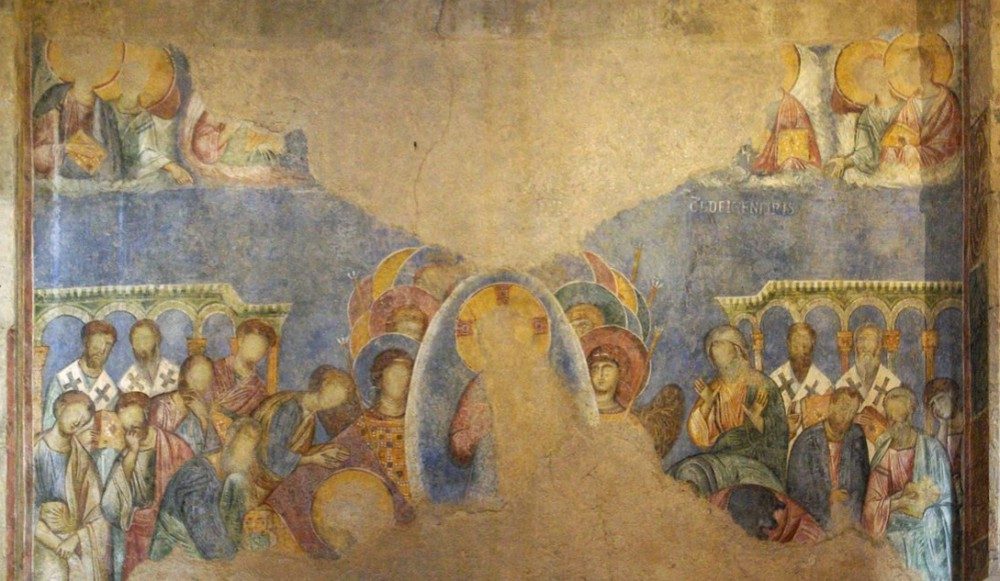
Unlike many sites in the Holy Land, no one seems to know, precisely, where Emmaus might have been. This uncertainty surprised me, while visiting the Holy Land recently. Emmaus, I should have thought, is the sort of place you might want to keep track of: it figured rather famously, after all, once long ago. The Resurrected Lord of the Universe met a pair of dispirited disciples there, in the evening of the original Easter day. He met them on the road, “going to a village called Emmaus” (Luke 24:13). Wherever it was.
Many put Emmaus in a place called Latrun, known as Nicopolis in ancient times. Others place it closer to Jerusalem – perhaps in Abu Ghosh, perhaps in a place called Qubeiba. New Testament manuscripts do not agree among themselves, as it turns out. Some manuscripts put the village at “sixty stadia” (about seven miles) distance from Jerusalem. Other ancient variations put it at “a hundred sixty stadia” (eighteen miles or so). None of the manuscripts give much sense of direction. Was the village 7 miles or 18 miles away from old Jerusalem? Did it lie to the north, south, east or west?
As for our little study group, we visited a lovely cathedral in the village of Abu Ghosh, built in Crusader times to honor the memory of Emmaus. The Crusaders, anyway, thought this may have been the original site, referenced in Luke 24. They measured a radius of sixty stadia around the old city of Jerusalem (cf. 24:13), found Abu Ghosh lying there, discovered a well in the middle of town (a likely meeting place for visitors passing through) and erected a church over the site. Why not?
This was a perfect way to identify Emmaus, I have since concluded. Of all the famous New Testament places, “Emmaus” could be anywhere. It should be anywhere, in fact. “Emmaus,” in a way, is an arbitrary waypoint along the pathway of our lives. It is not a distinctive destination – as you would say of Disneyland or the National Mall, for example. People pass through Emmaus, for the most part (Lk. 24:28). They stop, sometimes, only if “urged strongly” (Lk. 24:29).
No one seems to know who the two disciples were, either. One was named Cleopas, whoever that was. (Some think that he was the brother-in-law of Mary of Nazareth; some do not.) The other disciple isn’t identified at all. (Some think that she was the wife of Cleopas, whatever her name; some do not.) They are anonymous believers, more or less, on their way to an unidentified Emmaus.

The cathedral in Abu Ghosh continues the theme of anonymity. Its ceiling and walls must have taken your breath away, once upon a time: you can appreciate the vestiges of many colorful frescoes, depicting elaborate biblical scenes and mighty heroes of the faith. But their faces have been rubbed out, every one of them. The depictions offended Islamic sensibilities when Abu Ghosh was ruled by the Ottoman Empire. Its Ottoman stewards cleansed the images by rubbing out their faces. The heroes have become anonymous, every single one.
For Emmaus, in particular – this is perfect, I think.
Emmaus is anywhere. The disciples are any pair of believers. It is not latitude and longitude, or names and coordinates that put Emmaus on the map. It is Jesus. He meets his disciples – any one of us, anywhere we are – as we journey our way through life. Why, you still might expect to meet him along the road. Wherever you are. Maybe even today.
Two things happen in this encounter. The Lord reveals himself to the disciples: he creates in them the miracle of faith. And the disciples reveal the encounter to others: the Lord enlists them in his mission. This is the prototypical experience of our Christian faith: Jesus meets us; Jesus enlists us. And you don’t have to be “somebody” for this to be your own experience. You don’t have to be “somewhere” other than where you are, or in “some time” other than today.
You are on your own “road to Emmaus,” you see – and no scholar can prove to you otherwise. Jesus intends to meet you there. You may expect him to lead you into the Scriptures (Lk. 24:27). He may set your heart on fire (Lk. 24:32). And when you meet him, when he opens your heart in faith, you will find that he gives you something to share, as well – a Sure Truth to proclaim, a Gospel Story to tell, and a Mission to make disciples of all the peoples of the world.